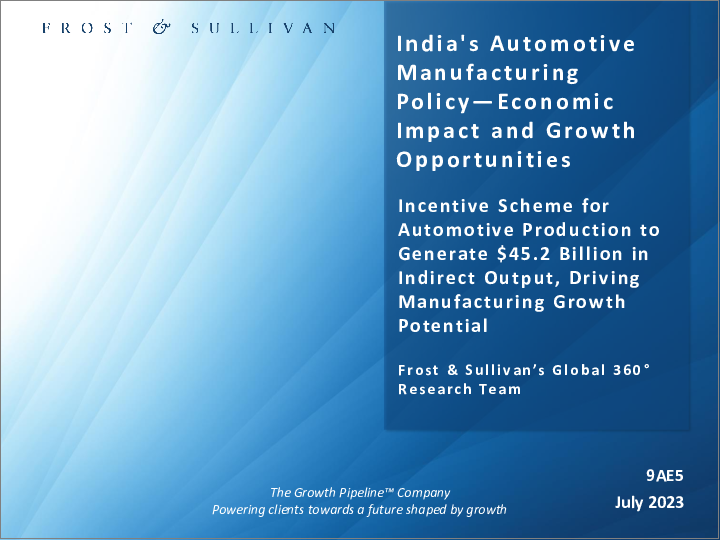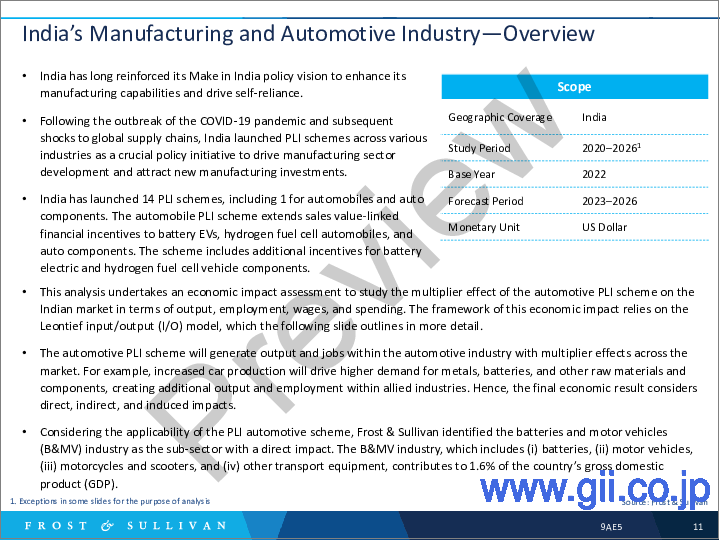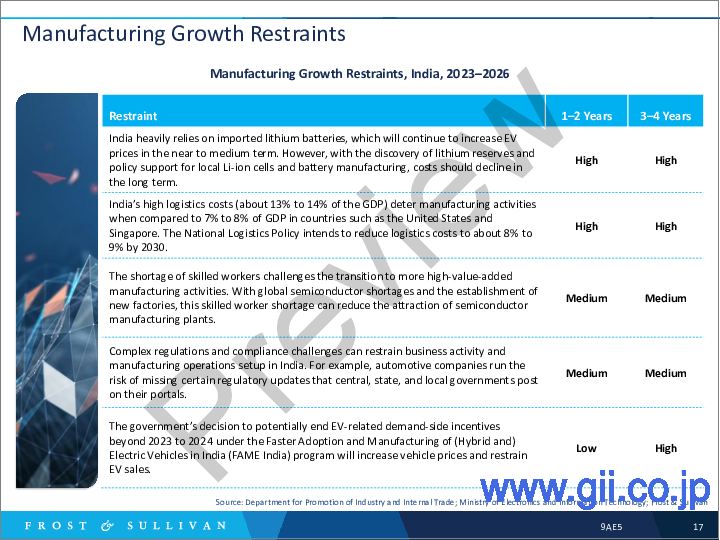|
|
市場調査レポート
商品コード
1322955
インドの自動車製造政策-経済への影響と成長機会India's Automotive Manufacturing Policy-Economic Impact and Growth Opportunities |
||||||
|
|||||||
| インドの自動車製造政策-経済への影響と成長機会 |
|
出版日: 2023年07月26日
発行: Frost & Sullivan
ページ情報: 英文 47 Pages
納期: 即日から翌営業日
|
- 全表示
- 概要
- 目次
自動車生産奨励金制度が間接生産に452億米ドルを創出、製造業の成長ポテンシャルを牽引
当レポートでは、インドの自動車製造政策、特に自動車・自動車部品向けPLI (生産連動奨励金) 制度の経済効果に焦点を当てています。COVID-19パンデミックの発生とそれに続く国際的サプライチェーンへのショックを受けて、インドは製造業の発展を促進し、新たな製造業投資を呼び込むための重要な政策イニシアチブとして、様々な産業で14のPLIスキームを開始しました。
自動車PLI制度は、バッテリー式電気自動車、水素燃料電池自動車、自動車部品に販売額に連動した金融優遇措置を拡大するものです。本研究では、自動車PLI制度がインド市場に与える影響を、生産、雇用、賃金、支出の観点から検証する経済効果評価を行います。この経済効果の枠組みは、レオンチェフの投入算出法 (I/O) モデルに依拠しています。
自動車PLI制度は、インド経済全体に乗数効果をもたらし、自動車産業における生産と雇用を創出します。例えば、自動車生産台数の増加は、金属、バッテリー、その他の原材料や部品に対する需要の増加を促し、関連産業における追加的な生産と雇用を生み出します。したがって、最終的な経済効果は、直接効果、間接効果、誘発効果を考慮したものとなります。本調査はまた、政府の支援政策、サプライチェーンの多様化動向、持続可能性の推進などの組み合わせから生じる、インドの製造業と自動車産業の成長機会にも焦点を当てています。
主な論点
- インドの製造業強化の背景にある戦略的要請とは何か?
- 自動車PLI計画は、関連産業や経済全体にどのような波及効果をもたらすのか?
- PLIスキームによる2026年の直接生産、粗付加価値、雇用への影響は?
- 自動車PLIスキームによる間接的・誘発的影響は、直接的影響と比較してどうか?
- 自動車PLIスキームの1秒当たり、1年当たりの生産高は?
- インドで自動車とサプライチェーンの製造能力を構築し、持続可能性を推進するために、インドにはどのような成長機会があるのか?
目次
戦略的課題
- なぜ成長が難しくなっているのか?
- The Strategic Imperative 8 (TM)
- インド経済における戦略的重要課題:上位3項目のインパクト
- Growth Pipeline Engine (TM):成長機会による促進
インドの製造業と自動車産業
- インドの製造業と自動車産業-概要
- 投入算出法とレオンチェフ乗数-イントロダクション
- 経済影響評価-影響形態の概要
- 経済影響評価-影響分析の種類
- 自動車PLI制度の影響に関する主な調査結果
- 製造業の成長促進要因
- 製造業の成長抑制要因
インドの製造業と自動車産業における政策の推進
- 製造業のビジョンと政策支援
- PLIスキーム:自動車PLIスキームの深掘り
経済影響評価の手法と枠組み
- 直接効果分析
- 間接的な生産とGVAの影響分析
- 間接雇用影響分析
- 誘発影響分析
経済影響評価結果
- B&MVのインド経済への貢献
- 電池と自動車に関するPLIスキームの影響調査結果
- 総経済生産インパクト
- 生産高とGVAにおける部門別シェア
- 雇用への影響
- 労働報酬への影響
成長機会ユニバース
- 成長機会1-PLIと世界・サプライチェーンの方向転換による製造業とインフラの強化
- 成長機会2-バッテリー式電気自動車と水素燃料電池自動車のサプライチェーン
- 成長機会3-リチウムイオン電池とサプライチェーンの成長
付録
- 産業セグメント
- 産業セグメント別の乗数
- 産業セグメント別の雇用統計
- 図表一覧
- 免責事項
Incentive Scheme for Automotive Production to Generate $45.2 Billion in Indirect Output, Driving Manufacturing Growth Potential
This research service focuses on the economic impact of India's automotive manufacturing policy, particularly the automobiles and auto components production-linked incentive (PLI) scheme. Following the outbreak of the COVID-19 pandemic and the subsequent shocks to global supply chains, India launched 14 PLI schemes across various industries as a crucial policy initiative to drive manufacturing sector development and attract new manufacturing investments.
The automobile PLI scheme extends sales value-linked financial incentives to battery electric vehicles, hydrogen fuel cell automobiles, and auto components. This study undertakes an economic impact assessment to examine the effect of the automotive PLI scheme on the Indian market in terms of output, employment, wages, and spending. The framework of this economic impact relies on the Leontief input/output (I/O) model.
The automotive PLI scheme will generate output and jobs in the automotive industry with a multiplier effect across the Indian economy. For example, increased car production will drive higher demand for metals, batteries, and other raw materials and components, creating additional output and employment in allied industries. Hence, the final economic result considers direct, indirect, and induced impacts. This study also highlights the growth opportunities in India's manufacturing and automotive industry arising from a combination of supportive government policies, supply chain diversification trends, and the sustainability push.
Key Issues Addressed:
- What is the strategic imperative behind the fortification of India’s manufacturing sector?
- What ripple effects will the automotive PLI scheme generate across allied industries and the larger economy?
- What will be the 2026 direct output, gross value-add, and employment impact of the PLI scheme?
- How do the indirect and induced impacts of the automotive PLI scheme compare to the direct impact?
- What is the per second and year output of the automotive PLI scheme?
- What growth opportunities does India present as it seeks to build local automotive and supply chain manufacturing capabilities and drive sustainability?
Table of Contents
Strategic Imperatives
- Why is it Increasingly Difficult to Grow?
- The Strategic Imperative 8™
- The Impact of the Top 3 Strategic Imperatives on the Indian Economy
- Growth Opportunities Fuel the Growth Pipeline Engine™
India's Manufacturing and Automotive Industry
- India's Manufacturing and Automotive Industry-Overview
- I/O Table and Leontief Multiplier-Introduction
- Economic Impact Assessment-Overview of Impact Forms
- Economic Impact Assessment-Types of Impact Analysis
- Key Findings on the Impact of the Automotive PLI Scheme
- Manufacturing Growth Drivers
- Manufacturing Growth Restraints
Policy Thrust in India's Manufacturing and Automotive Industry
- Vision and Policy Support for Manufacturing
- PLI Schemes-Deep Dive of Automotive PLI Scheme
Methodology and Framework for Economic Impact Assessment
- Direct Impact Analysis
- Indirect Output and GVA Impact Analysis
- Indirect Employment Impact Analysis
- Induced Impact Analysis
Results of Economic Impact Assessment
- B&MV's Contribution to the Indian Economy
- Impact Findings of the PLI Scheme on Batteries and Vehicles
- Total Economic Output Impact
- Sectoral Share in Output and GVA
- Total Employment Impact
- Impact on Labor Compensation
Growth Opportunity Universe
- Growth Opportunity 1-Manufacturing and Infrastructure Boost from PLI and Global Supply Chain Reorientation
- Growth Opportunity 2-Battery Electric and Hydrogen Fuel Cell Vehicles Supply Chain
- Growth Opportunity 3-Lithium-ion Battery and Supply Chain Growth
Appendix
- Industry Segments
- Multiplier by Industry Segment
- Employment Statistics by Industry Segment
- List of Exhibits
- Legal Disclaimer






